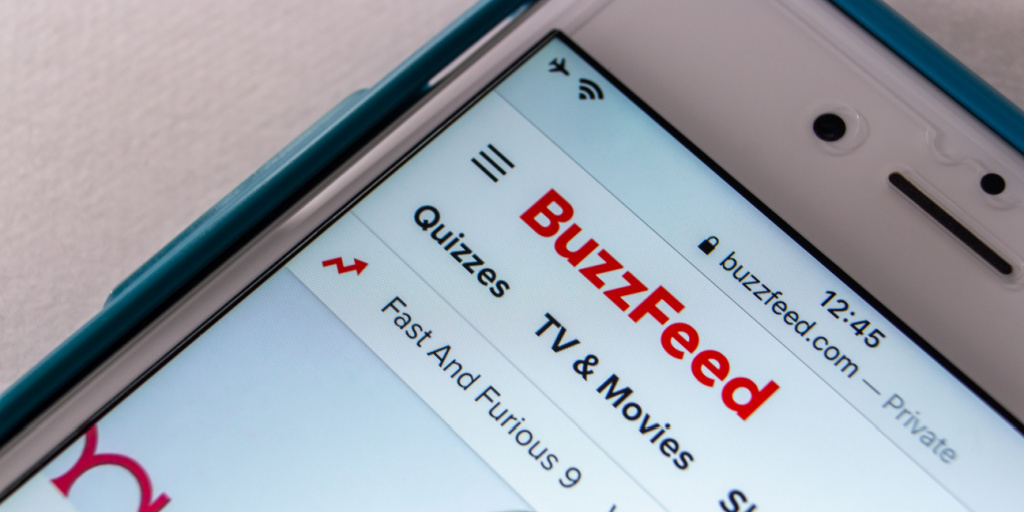The Buzz on Buzzfeed
In 2023, Buzzfeed and Vice announced that they were shutting down the news sections of their websites. In its short life, Buzzfeed news made the Steele Dossier available and its reporting on the treatment of Uyghurs in Xinjiang received a Pulitzer Prize. At one point upstart social media news companies like Buzzfeed seemed poised to devour the New York Times, now the clear winner of the web news wars. How and why did Buzzfeed (and others, such as the Huffington Post) rise so spectacularly and recede with little notice? This is the story Ben Smith tells in Traffic: Genius, Rivalry, and Delusion in the Billion-Dollar Race to Go Viral.
The book examines the pursuit of traffic by a number of leaders in the social media world based primarily in New York City during the first decade and a half of the twenty-first century. Eschewing opportunities to analyze the industry or its effects on politics, the book is primarily a story that follows the trajectory of Jonah Paretti (Huffington Post, Buzzfeed), Nick Denton (Gawker, Jezebel), and the people who entered and exited their social and professional networks. The author, Ben Smith, was a principal actor in much of the drama.
Smith, an early writer of political blogs, moved to Politico before becoming the director of news at Buzzfeed. He later was the media columnist at the New York Times and co-founder of Semfor. Smith built the Buzzfeed news team and was part of an inner circle at Buzzfeed. He was present when Disney made a bid for the company, and he made the decision to publish the Steele Dossier on the Internet.
Traffic begins and ends with a bet between two MIT students, Jonah Paretti and Cameron Marlow, about whether one could make a post go viral or whether the internet’s whims were random and unpredictable. Paretti believed he could manipulate reactions and he spent a decade and a half learning to understand and direct internet traffic. Shortly after describing the bet, Smith introduces Nick Denton, a reckless, dot-com entrepreneur who saw the internet as the necessary instrument to rip apart the establishment and its moral values, initiating a new radical regime of transparency.
The story is, perhaps unintentionally, tragic, a tale of innocence lost. Denton, from about 2010, began to transform, mellow, and even have doubts about the behavior in which he engaged—and in which his companies continued to engage. He learned he was not simply a force of transparency but that there was something wrong with exposing the personal lives (intimate texts and images) of other people, even if they happened to be hypocrites. Paretti seemed to game the internet, but Smith concludes that the internet was in fact beyond them; there is a randomness to it. Or at least, it looks that way from where we stand, since there might be bigger forces manipulating things behind the scenes. One such figure was Peter Thiel, who was behind the ultimate defenestration of Gawker and Denton. If Paretti won the bet, the victory was pyrrhic.
In the midst of all this drama, Smith offers a worm’s eye view of how pranks, wild ideas, and conversations at parties in lower Manhattan and Brooklyn, led to consequential projects with enormous consequences. The desire to advance progressive politics and challenge the NRA and others mostly on the political right were juxtaposed against the desire to win the attention of millions of people who were simply bored at work (or in life).
Myspace-era diary-writing (about me) gave way to more developed blogs (mostly about me) and then to communicating within a social media environment (about me, the things other people do and say that I do or do not like). This shift allowed for a sense of intimacy, but also made it easier to reveal the intimate to clusters of people with great speed—radical privacy matched with intense publicity. With the development of smartphones, it became possible to capture photographs and scrawl hasty comments on the fly, sharing them with the entire world and not just an email list. This encouraged snarky witticisms and erotic playfulness. There were plenty of indiscreet, impolitic, unwise, and nasty thoughts, images, and videos.
Traffic discusses how certain types of indiscrete content were published and commented upon by social media companies’ new cadre of journalists. Early on, this content was the main product, not just bait. Oddly, Traffic reveals that there was little discussion of what should be shared—that there might be limits to decency—only whether a published secret would harm a hypocrite, and whether there was legal protection for doing so.
There certainly was ethics at play: the establishment media and society were viewed as stodgy and elitist, brakes and roadblocks on the way to truth and progress that could now be bypassed. Traffic should be unimpeded. There were also clear monetary rewards for the pursuit of traffic but many, Paretti particularly, seemed less interested in cashing out than in capturing the power and status that new media seemed to promise. That power was both commercial and linked to humiliating politicians on the right.
The next few years saw the rise and fall of various social media companies, some of which offered little more than a new form of stalking (oddly, TMZ was not discussed in the book). Gawker embarrassed many a public official by publicizing material that would never otherwise have been known. But a lawsuit launched by Hulk Hogan, the wrestler whose tryst with his best friend’s wife was revealed in video form on Gawker, eventually crippled Gawker. Smith notes Thiel financed the lawsuit and saw it as payback for a slight by Denton years earlier. Thiel’s ability to, eventually, settle scores, was evidence for Smith that however much he and his cohort were able to generate traffic, the internet was also beyond them. However big they were, Thiel and his cohort were bigger.
Though Traffic primarily tells the story of Buzzfeed, it gives modest attention along the way to the rise of Facebook and Google, and the turnaround in the New York Times. Around 2009, a temporary error in Google sent traffic to ‘buzzfed’ rather than Buzzfeed, causing Buzzfeed’s traffic from Google, the main source of eyeballs, to crash. This forced some re-thinking and a new strategy focused on working through Facebook. When Google corrected the error, Buzzfeed was able to benefit from both sources of traffic: one keyword-based and the other centered around social media. This new strategy took advantage of the opening of Facebook to non-collegiate consumers and its subsequent growth as the “most important source of traffic.” Embedding in social networks was particularly important in growing Buzzfeed and creating a sense of community that eventually led to news.
At the end of Traffic, one is moved to ask: how is it that a collection of adults, almost all of whom were educated at some of the finest universities in the United States, gave so little thought to the personal costs of revealing personal secrets?
Buzzfeed realized that further growth required developing a news department and Smith, then working at Politico, was brought on. Smith assembled a news team, experimented with hiring a conservative writer (which ended poorly), and published the Steele Dossier. During his tenure, Buzzfeed was almost purchased by Disney, and that episode reads like a movie script: the big corporate giant does not understand but wants to buy the rebellious upstart who, eventually, backs out in order to protect autonomy and values. Smith seems to be proud of that decision, though the Disney deal was the best Buzzfeed would be offered.
Perhaps the most consequential of Smith’s decisions was the publication of the dossier associated with British intelligence agent Christopher Steele, which contained numerous allegations that Russian President Vladimir Putin had compromising information on recently-elected US president Donald Trump. Smith explained how traditional media outlets had seen the information but decided against publishing it because of an inability to find corroborating sources. Smith, with his leadership and in consultation with the Buzzfeed legal team, deliberated and eventually decided to post the full dossier online alongside a brief explanation that the document contained some false information and other information that could not be verified.
The caveat given, the dossier entered into cyberspace and was now open to interpretation by all and sundry. To many, the narrative seemed clear. The establishment media in their elitist, paternalistic, patronizing way had kept it from the public and Buzzfeed was now driving the bus. It was paradigmatic of new social media’s pretensions: the release into an open forum of the scandalous personal activity of one of the world’s most talked about celebrities, a leader of the conservative political movement. The stodgy, gray, old lady would never have allowed it. It was a splendid hat trick. But, unlike video uploads and leaked audio, the report contained only allegations, and the Buzzfeed staff knew that the caveats included with the document would not get much attention.
Traffic is a good, fast-paced read. It does miss important opportunities. It gives little attention to Facebook and Google, which were giants in the ecosystem and also very consequential actors in the rise of Buzzfeed. Similarly, it does not spend much time exploring the demand side for Buzzfeed’s content: the abnormally large contingent of millennials and older post-millennials who were early in their careers, or came of age during the 2008 economic crash and its fallout. They joined and intensified a long-term trend in declining fertility and labor rate participation, lived at home with their parents longer than earlier generations, and were increasingly skeptical of the possibility of socioeconomic advancement. The population was particularly ripe for the medium and content that Buzzfeed and others had on offer.
Smith largely avoids analyzing the behavior of his characters and offers no judgment. The only justification seems a lukewarm one for publishing the Steele Dossier. Avoiding judgment is generally helpful though, at least in an epilogue, and a revelation of a more mature Smith’s thoughts on the excesses of the era would have been revealing. More importantly, greater analysis of the consequences of the behavior would have been welcome. For this, a reader interested in Traffic should consider reading the works of Han Byung-Chul whose writings about the impact of new media forms on human life and culture are very worthwhile.
At the end of Traffic, one is moved to ask: how is it that a collection of adults, almost all of whom were educated at some of the finest universities in the United States, gave so little thought to the personal costs of revealing personal secrets? Smith reveals the points that were the focus of deliberation: “Can we really do this?” . . . “This would be cool or offer some comeuppance.” . . . “These hypocrites deserve this.” Did no one really think that there was a human cost to such visual and explicit exposés?
Smith explains that they were engaging in a different sort of journalism, more edgy and amateurish, but still, Traffic seems to justify the absence of such reflection because smart people were simply following through on a bet, in a fast-paced world cheered on by a massive movement of money and attention. Smith compares himself and Paretti to Rosencrantz and Guildenstern, noting that they were really actors in someone else’s play. That seems unsatisfying—particularly if the actors described are not merchants of commonplace knick knacks but people who communicate the majority of the information about the world that people consume on a regular basis. It is all the more unsatisfying when Buzzfeed news won a Pulitzer Prize for its important reporting on mass detention in China. It was not just stalking 2.0 but it was not entirely journalism either. Or was it?


